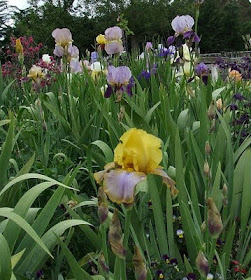.

Fantastic!! the ASI Year Book has arrived and as usual it is an informative read. Once again brilliantly Edited by Thomas Fietz.
The Aril featured on the cover 'Hakuna Matata' (A & D Cadd) Mohr Medal Winner 2007. Cover credit ASI.
For all you folks that visit this blog and there are many of you (By the way Thanks once again for visiting) The Year Book is distributed to members of ASI anually 165+ pages of information and a large amount of colored photos of Aril Irises.
A selection of Articles 2007 issue are as follows
* The importance of the Clarence G White 'Oncobreds' in the developement of the new Arilbred Irises. H.V Slamova
* Taking Digital Iris Photographs. A Moran
* Part I; The Equipment. A Moran
* Part II; Taking the Picture. A Moran
* Part III; Working with your pictures. A Moran
* Enhanced Germination Techniques. S McAllister
* A new population of the rare Iris westii from Mount Hermon. O Fragman-Sapir
Iris lovers worldwide who wish to receive quality Aril iris information plus the many other benefit's of membership should give serious thought to Join The Aril Society International it's a great investment.The best Membership Deal is $28.00 US triennial which includes $12.00 credit for the plant sale in the first year of membership or when renewing membership. Australian and New Zealand members receive an $8.00 credit voucher for the Seed Exchange in the first year of triennial membership or triennial renewal.
Membership of the ASI has so much to offer there is the ARILROBIN, Yearbook, Newsletters, Seedlist, Rhizome sale and fellowship of those of us who marvel at the beauty of the arils and all of this at a super reasonable price
ASI Checklist (Cover Photo)
Hakuna Matata OGB - A. & D. Cadd, R. 1999). Sdlg. 12-92-1. AB, 24-28”, (61-71cm), VE & RE. S. straw yellow, brown infusion; syle arms slightly darker yellow; F. straw yellow, maroon brown area around beard with radiating darker maroon brown lines; beards brown, tipped yellow; lightly fragrance. Jolt X Dawn Victory; ruffled; slight musky Available in America from Andiris Gardens
*****
















